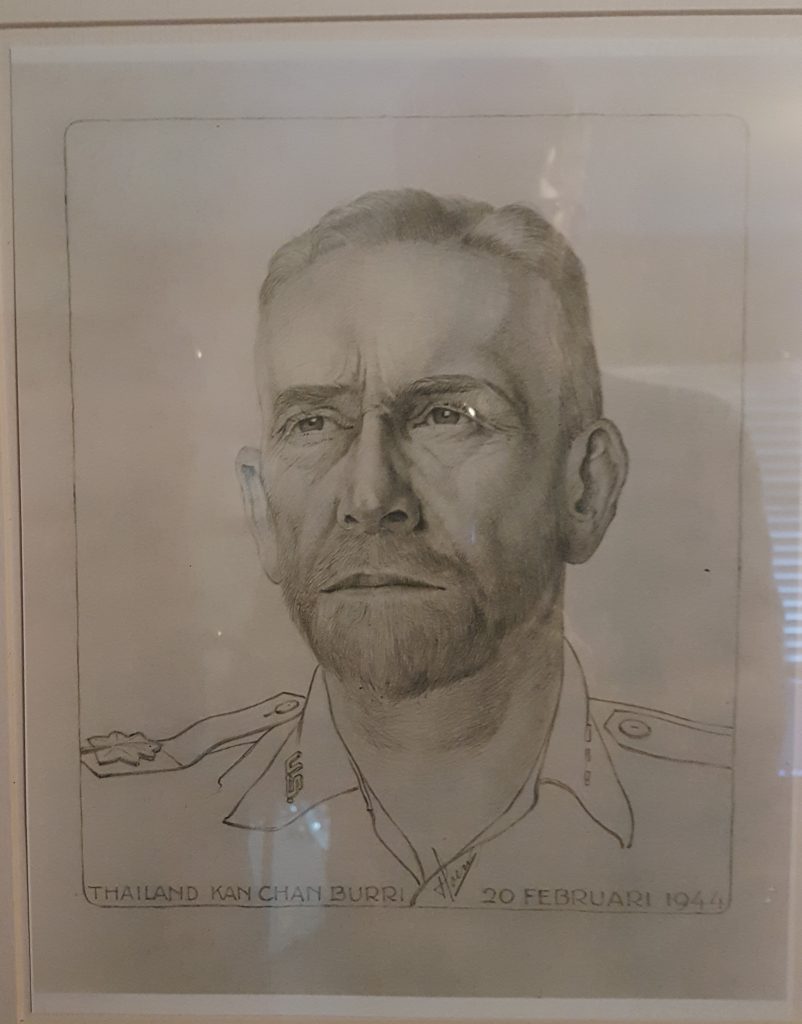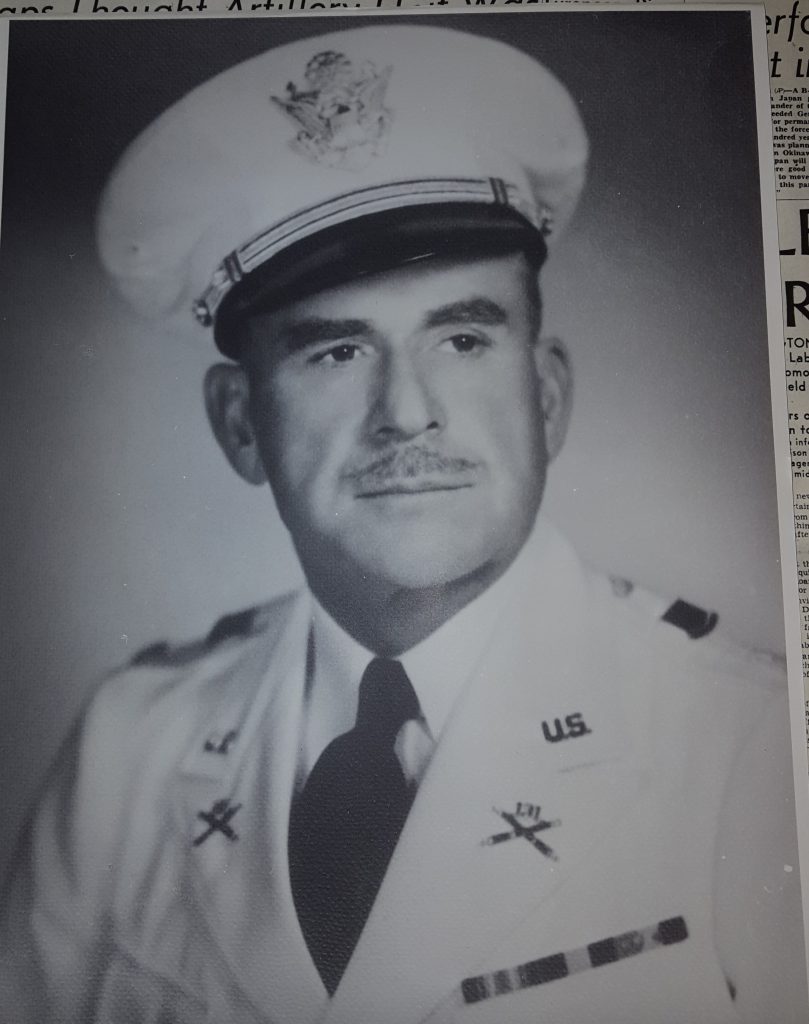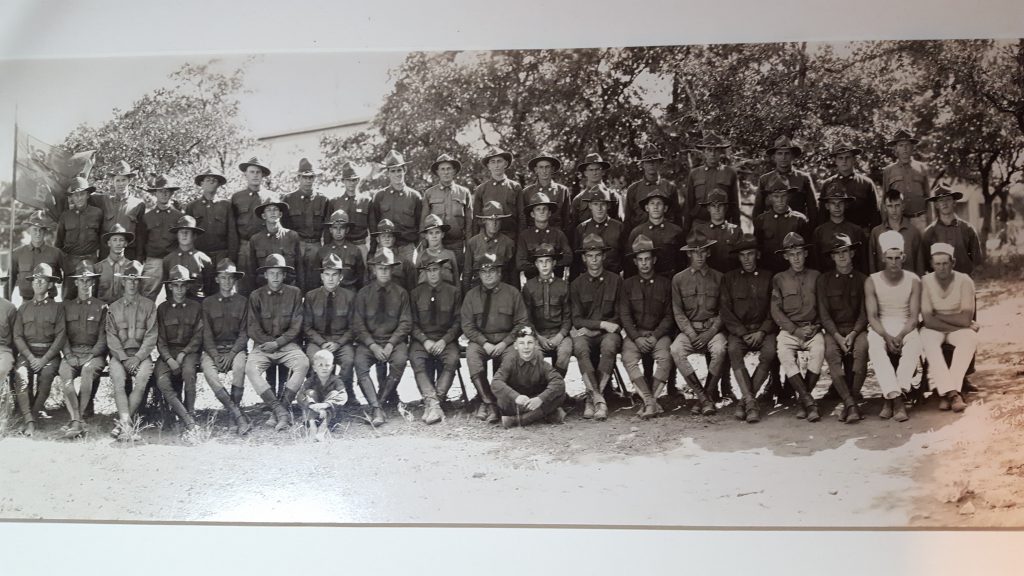He enlisted in Troop B, 1st Texas Cavalry on 2 July 1916 and saw service on the Mexican border. He was mobilized with the 36th Infantry Division for World War I as a member of Battery B, [1st Bn] 131st Field Artillery (FA) and rose through the ranks to Regimental Sergeant Major of the 131st FA Regiment.
He attended an Officer Training Course at Camp Bowie, Texas, and was commissioned a second lieutenant on 1 JUN 18. He was released from active duty on 9 JAN 19.
He joined the 131st FA again on 4 FEB 24, serving in various assignments culminating with his assignment as Battalion Commander, 1st Battalion, 131st FA as a Lieutenant Colonel on 12 AUG 40.
After the mobilization and then re-organization of the 36th Division, he was placed in command of the 2nd Battalion, 131st FA and took that unit overseas to the Pacific theater on 11 NOV 41. His unit was diverted from the Philippines when Pearl Harbor was attacked and finally landed on the island of Java, Dutch East Indies. He and his entire battalion were taken prisoner when the Dutch surrendered to the Japanese in mid-March 42. His battalion became known as the “Lost Battalion” as they remained prisoners of the Japanese until the end of the War. He was promoted Colonel while still a prisoner and upon his return remained in the active army until his retirement in 1947.
He was a fine leader (see below), loved and respected by his men and his community. Among his many decorations were the Bronze Star, Purple Heart and the Presidential Unit Citation with three clusters.



While most of the Guardsmen held him in high esteem, a few — in interviews later in life — questioned his support for the enlisted men. They cite two main objections to his leadership in the camps: 1) he allowed the officers to remain apart from the others and did not insist that they intervene on the behalf of the lower ranks; 2) while stopping short of calling him a ‘collaborator’, they relate that — in their mind — he was much too accommodating to the various camp commanders and overseers. They thought that he could have fought harder on their behalf versus the demands being made on them by the IJA.
In his defense, it is possible that he chose to ‘pick his battles’ and did not always stand up to the demands. Unfortunately, he never did an interview nor wrote about his POW experience, so we will never hear his side of the story.
His sheer presence with the Battalion throughout most of their ordeal is likely an indication of his persuasive abilities. As has been noted, the IJA generally kept the various nationalities together as a group while ignoring their branch of service. It is also true that they often separated the officers from the other ranks. This happened with the the Navy and Marine officers from the USS HOUSTON who had been sent off to Japan before the TXNG arrived at the Bicycle Camp. One has to wonder why that did not occur with the Army officers. It is not well documented but it seems that Tharp simply refused to be separated from his men. He stayed in command until well into 1945. In what turned out to be the latter months of the war, the Japanese first moved the remaining officers at Kanchanburi to a separate compound near the Paper Factory. Then they began moving them to a new camp at Nakorn Nayok. Tharp was one of the last officers to arrive there, literally only days before war’s end. He quickly managed to return to Bangkok to begin the process of repatriation.
Part 2: Health as POW
We actually know very little first-hand information about LTC Tharp’s time as a POW. In the rare instances where the POW survivor accounts actually mention him, it is usually simply an acknowledgement of his leadership. The vast majority of these accounts were written by enlisted men who would have had only passing association with him on a day-to-day basis.
However, there is a letter written in 1958 by his Executive Officer, MAJ Winthrop “Windy” Rogers. He is seemingly writing a To Whom It May Concern statement to support Tharp’s claim for post-war benefits. In it, he details how he watched Tharp’s health deteriorated rapidly during their time at the Bicycle Camp on Java. Between MAY and OCT 42, he says Tharp had lost 30 pounds and was suffering from Dengue fever. Then, during their 3 months in Singapore he contracted malaria and beri-beri.
He adds a new fact to the B-24 bomb attack of the Moji Maru while en route to Burma: Tharp was wounded in the scalp by a fragment and continued to suffer after effects for the rest of his life. Apparently, Tharp was held back at Moulmein for a short time before moving on to the TBR due to that wound. Rogers and Tharp were separated for a while as the POWs moved about at different camps in Burma. When they reunited in MAR 43, Rogers was shocked at his status. A few weeks later, as the group moved yet again, Tharp was placed on an ox cart, too weak to walk. The deeper they moved into the Burmese Highlands the worse the food situation became and their health across the board deteriorated even further.
By the time the TBR was completed in OCT 43, both he and Tharp were experiencing near blindness due to vitamin deficiency! Tharp was among the first men of his group to be moved out of the jungle to Kanchanaburi due to his ill-health. He was carried on a litter during that journey by train. He apparently was at the ChungKai hospital for some time before arriving at the Tamarkam Camp in MAY 44. Per Rogers, he had improved somewhat but was still walking with a cane. Rogers remarks that he appeared to be 90 years old!
Rogers fails to describe Tharp’s health in the latter days of the war and into the liberation phase. By his own accounts, Tharp was quite active and diligent in rounding up his charges from the many places they had been dispersed to after the Tamarkam Camp. His diary entries from that period show him to be clear headed and concerned about the health and safety of his men. One can only assume that the worst of his health issues had improved if not actually resolved.
In addition to the above diseases, Rogers adds Scurvy and tropical ulcers to Tharp’s maladies; as well as commenting that he had been severely beaten on a number of occasions, apparently for his efforts to stand up for his men.
Rogers closes by noting that in the post-war years, both he and Tharp had developed Diabetes which he could not directly attribute to their POW time. COL Tharp is recorded as having died in 1954 while in a diabetic coma. It is then unclear why the letter of note was written in 1958 or at whose request.
[Rogers who was 12 yrs younger than Tharp lived until 1984]
Tharp and Toosey
British LtCol Toosey (see Section 3.7.2) was the true-life LTC Nicholson who actually oversaw the the POWs who built the famous bridges. He did not oversee the building as Nicholson did, but that’s another story. It appears as if he and LTC Tharp overlapped at least twice. Once at Kanchanaburi before Toosey was sent back to NongPlaDuk and then again in the final weeks of the war when they were both transferred to the Nakorn Nayok officer’s camp. It would seem that these men discussed what would be needed at the end of the war and cooperated in gathering their men.
An example of this is that many of Toosey’s artillery battalion had been sent to Ubon. Almost immediately after hostilities ceased, Toosey traveled there to begin to move those men. When he found 4 Americans there — it is not clear if he knew to expect them — he arranged for them to be placed on the train returning to Bangkok as ‘attendants’ for the ill men. In this way, they were among the first to be repatriated. (see Section 8.13 for the full story)
